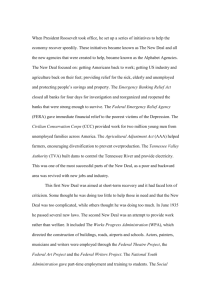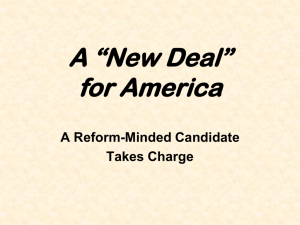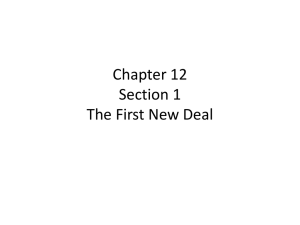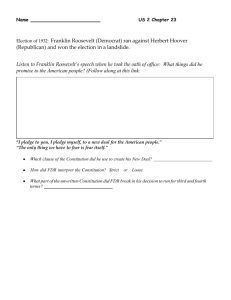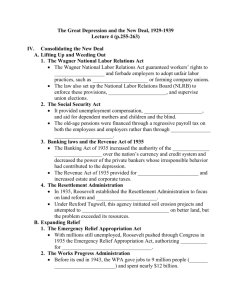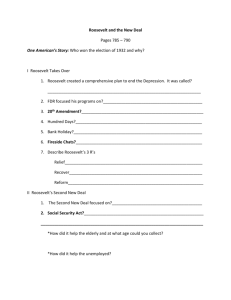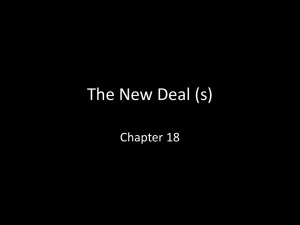FDR and the New Deal - Wayzata Public Schools
advertisement
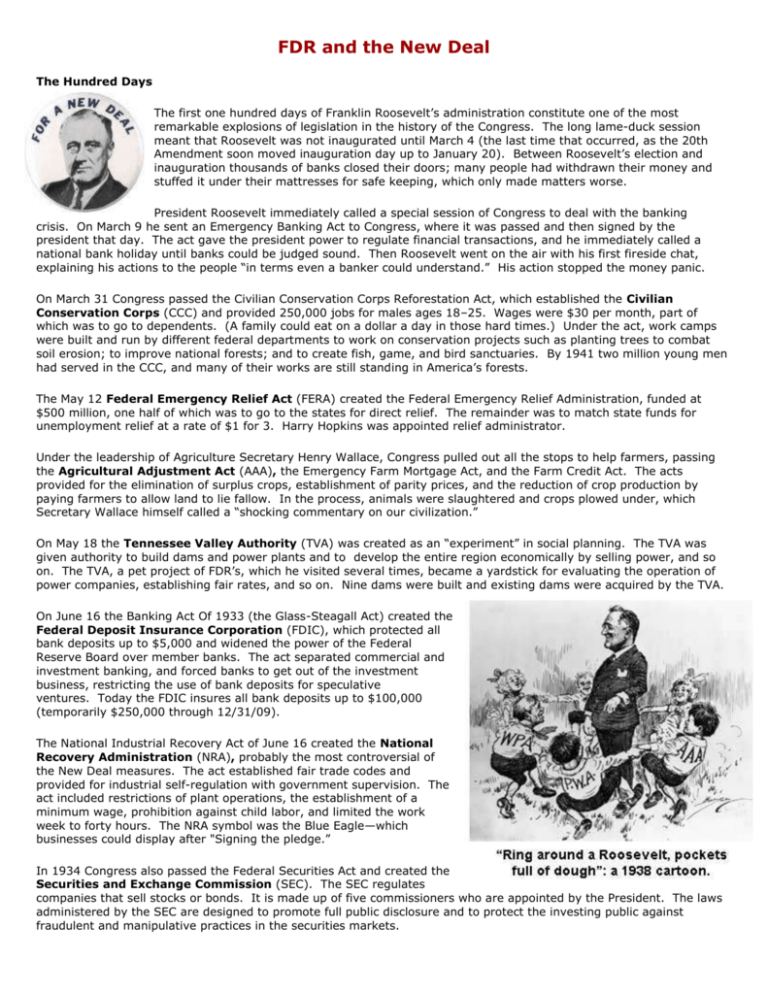
FDR and the New Deal The Hundred Days The first one hundred days of Franklin Roosevelt’s administration constitute one of the most remarkable explosions of legislation in the history of the Congress. The long lame-duck session meant that Roosevelt was not inaugurated until March 4 (the last time that occurred, as the 20th Amendment soon moved inauguration day up to January 20). Between Roosevelt’s election and inauguration thousands of banks closed their doors; many people had withdrawn their money and stuffed it under their mattresses for safe keeping, which only made matters worse. President Roosevelt immediately called a special session of Congress to deal with the banking crisis. On March 9 he sent an Emergency Banking Act to Congress, where it was passed and then signed by the president that day. The act gave the president power to regulate financial transactions, and he immediately called a national bank holiday until banks could be judged sound. Then Roosevelt went on the air with his first fireside chat, explaining his actions to the people “in terms even a banker could understand.” His action stopped the money panic. On March 31 Congress passed the Civilian Conservation Corps Reforestation Act, which established the Civilian Conservation Corps (CCC) and provided 250,000 jobs for males ages 18–25. Wages were $30 per month, part of which was to go to dependents. (A family could eat on a dollar a day in those hard times.) Under the act, work camps were built and run by different federal departments to work on conservation projects such as planting trees to combat soil erosion; to improve national forests; and to create fish, game, and bird sanctuaries. By 1941 two million young men had served in the CCC, and many of their works are still standing in America’s forests. The May 12 Federal Emergency Relief Act (FERA) created the Federal Emergency Relief Administration, funded at $500 million, one half of which was to go to the states for direct relief. The remainder was to match state funds for unemployment relief at a rate of $1 for 3. Harry Hopkins was appointed relief administrator. Under the leadership of Agriculture Secretary Henry Wallace, Congress pulled out all the stops to help farmers, passing the Agricultural Adjustment Act (AAA), the Emergency Farm Mortgage Act, and the Farm Credit Act. The acts provided for the elimination of surplus crops, establishment of parity prices, and the reduction of crop production by paying farmers to allow land to lie fallow. In the process, animals were slaughtered and crops plowed under, which Secretary Wallace himself called a “shocking commentary on our civilization.” On May 18 the Tennessee Valley Authority (TVA) was created as an “experiment” in social planning. The TVA was given authority to build dams and power plants and to develop the entire region economically by selling power, and so on. The TVA, a pet project of FDR’s, which he visited several times, became a yardstick for evaluating the operation of power companies, establishing fair rates, and so on. Nine dams were built and existing dams were acquired by the TVA. On June 16 the Banking Act Of 1933 (the Glass-Steagall Act) created the Federal Deposit Insurance Corporation (FDIC), which protected all bank deposits up to $5,000 and widened the power of the Federal Reserve Board over member banks. The act separated commercial and investment banking, and forced banks to get out of the investment business, restricting the use of bank deposits for speculative ventures. Today the FDIC insures all bank deposits up to $100,000 (temporarily $250,000 through 12/31/09). The National Industrial Recovery Act of June 16 created the National Recovery Administration (NRA), probably the most controversial of the New Deal measures. The act established fair trade codes and provided for industrial self-regulation with government supervision. The act included restrictions of plant operations, the establishment of a minimum wage, prohibition against child labor, and limited the work week to forty hours. The NRA symbol was the Blue Eagle—which businesses could display after "Signing the pledge.” In 1934 Congress also passed the Federal Securities Act and created the Securities and Exchange Commission (SEC). The SEC regulates companies that sell stocks or bonds. It is made up of five commissioners who are appointed by the President. The laws administered by the SEC are designed to promote full public disclosure and to protect the investing public against fraudulent and manipulative practices in the securities markets. That huge outpouring of legislation brought the hundred days to an end, but the New Deal continued to expand government activity throughout 1933 and into 1934 and ’35. Although the New Deal measures were considered radical by many at the time, the social and economic reforms introduced by Roosevelt had been common in Europe for some time. The most remarkable aspect of the New Deal, especially in its early days, was the speed with which it was put into practice. Just as remarkable, the New Deal suddenly brought millions of average Americans an awareness of government that they had never had before. Government now became a part of people’s daily lives. The Second New Deal Roosevelt launched what he called the Second New Deal in June, 1935. It included the following: The Social Security Act (SSA), probably the high point of Roosevelt's New Deal, included a pension fund for people over the age of 65. Although the first payments ranged only from $10-$40 per month, they provided minimal relief for people on the edge of starvation. As Roosevelt stated at the time, old-age Social Security was never meant to be a retirement program of its own; it was designed merely to supplement income which people had from other sources. Social Security also established a federal and state unemployment program which was financed by payroll taxes on businesses. The act also provided additional relief for dependent children, the disabled and other such dependent persons. A measure of the persistence of the New Deal’s legacy is the fact that Social Security is still central to the ongoing political debate in the country. Most Americans have come to see Social Security as an expectation, and fears that the funds available to provide Social Security payments will be insufficient have already generated modifications to the system, as the age when full payments begin has been gradually raised. Another important component of the second new deal was the Works Progress Administration (WPA), which over the course of its lifetime built hundreds of buildings bridges, roads, airports, schools and other public buildings such as post offices. By the time it ended during the Second World War, over 9 million people had been employed by the WPA. Cornerstones of many buildings still in use bear the WPA imprint. Still the Depression lingered on, and the extended periods of unemployment that kept thousands in poverty took a grave toll on substantial portions of the population. Marriages were delayed, birthrates plummeted, and a federal bureau determined that approximately 20% of all American children were underfed. Armies of men, women and even children rode the rails in search of employment or any opportunity to improve their poverty-stricken lives. FDR signs the Social Security Act

